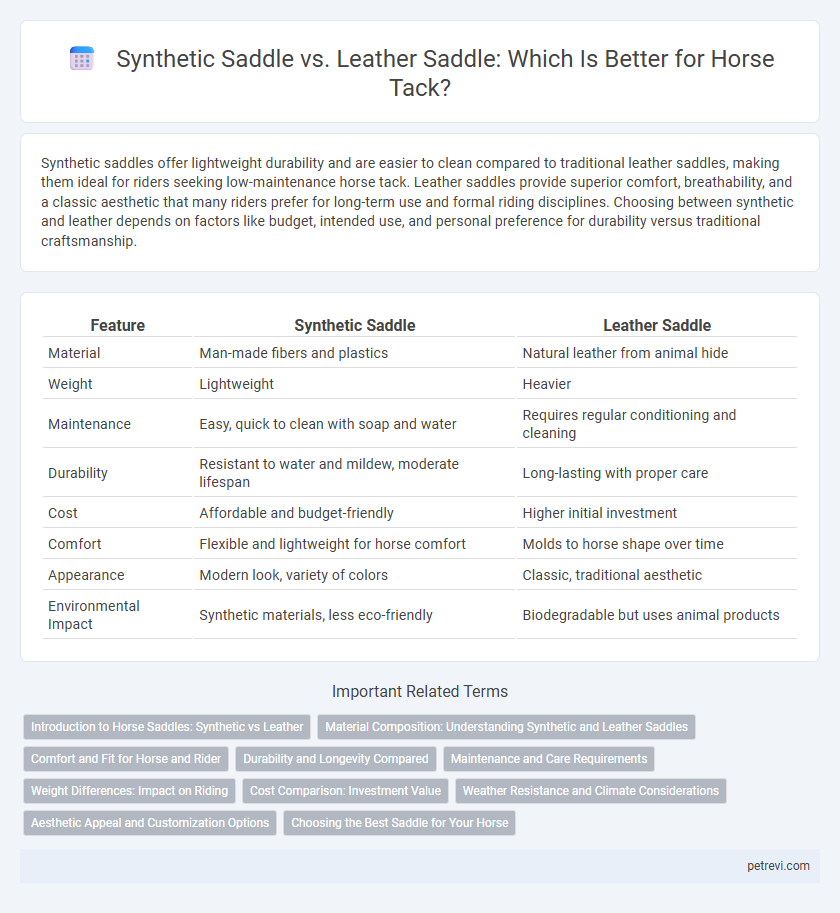Synthetic saddles offer lightweight durability and are easier to clean compared to traditional leather saddles, making them ideal for riders seeking low-maintenance horse tack. Leather saddles provide superior comfort, breathability, and a classic aesthetic that many riders prefer for long-term use and formal riding disciplines. Choosing between synthetic and leather depends on factors like budget, intended use, and personal preference for durability versus traditional craftsmanship.
Table of Comparison
| Feature | Synthetic Saddle | Leather Saddle |
|---|---|---|
| Material | Man-made fibers and plastics | Natural leather from animal hide |
| Weight | Lightweight | Heavier |
| Maintenance | Easy, quick to clean with soap and water | Requires regular conditioning and cleaning |
| Durability | Resistant to water and mildew, moderate lifespan | Long-lasting with proper care |
| Cost | Affordable and budget-friendly | Higher initial investment |
| Comfort | Flexible and lightweight for horse comfort | Molds to horse shape over time |
| Appearance | Modern look, variety of colors | Classic, traditional aesthetic |
| Environmental Impact | Synthetic materials, less eco-friendly | Biodegradable but uses animal products |
Introduction to Horse Saddles: Synthetic vs Leather
Synthetic saddles offer lightweight durability and ease of maintenance, making them ideal for riders seeking low-cost and weather-resistant options. Leather saddles provide traditional craftsmanship, superior comfort, and enhanced grip, favored in disciplines valuing classic aesthetics and long-term investment. Both saddle types impact horse performance and rider experience through material flexibility, weight, and fit, influencing overall tack selection for different riding styles.
Material Composition: Understanding Synthetic and Leather Saddles
Synthetic saddles are typically made from durable materials such as nylon, synthetic leather, and various polymers, offering lightweight and easy-to-clean options for horse tack. Leather saddles, crafted from animal hide, provide natural breathability, flexibility, and classic aesthetics, often requiring regular maintenance to preserve longevity. Comparing material composition reveals synthetic saddles excel in affordability and weather resistance, while leather saddles deliver superior comfort and traditional craftsmanship.
Comfort and Fit for Horse and Rider
Synthetic saddles offer enhanced comfort through lightweight materials that reduce strain on both horse and rider, promoting better fit and easier adjustment. Leather saddles provide a traditional, molded fit that conforms to the horse's anatomy over time, offering durability and breathability essential for long rides. Choosing between synthetic and leather saddles depends on the specific needs of comfort, maintenance, and the intended riding discipline.
Durability and Longevity Compared
Synthetic saddles offer superior resistance to water, mold, and UV damage, making them highly durable for varied weather conditions and requiring less maintenance than leather. Leather saddles, while offering unmatched comfort and natural breathability, demand regular conditioning to prevent cracking and wear, which can compromise longevity. Overall, synthetic saddles typically provide longer-lasting performance with minimal upkeep, whereas leather saddles require consistent care to maintain durability and extend service life.
Maintenance and Care Requirements
Synthetic saddles require minimal maintenance, needing only regular rinsing with water and occasional application of synthetic saddle cleaner to prevent dirt buildup and maintain flexibility. Leather saddles demand more intensive care, including daily wiping, conditioning with leather oils or balms to prevent drying and cracking, and proper storage to avoid moisture damage. The low-maintenance nature of synthetic saddles makes them ideal for riders seeking durability and ease of care, while leather saddles offer traditional aesthetics but require consistent upkeep to retain quality and longevity.
Weight Differences: Impact on Riding
Synthetic saddles typically weigh 3 to 5 pounds less than traditional leather saddles, reducing overall tack weight and lessening strain on the horse during rides. Lighter saddles contribute to enhanced horse comfort and increased rider endurance, especially in long-distance or competitive events. Weight differences influence saddle performance and can affect the horse's gait and responsiveness under various riding conditions.
Cost Comparison: Investment Value
Synthetic saddles generally cost between $300 and $1,000, offering affordability and requiring minimal maintenance, which reduces long-term expenses. Leather saddles range from $1,000 to over $5,000, providing durability and potential for increased resale value that justifies the higher initial investment. Evaluating both upfront costs and longevity helps determine the best saddle investment based on budget and usage frequency.
Weather Resistance and Climate Considerations
Synthetic saddles offer superior weather resistance compared to leather saddles, making them ideal for humid or wet climates as they do not absorb water and dry quickly. Leather saddles require regular maintenance and conditioning to prevent damage from moisture, which can lead to cracking and deterioration in rainy or damp environments. Riders in variable climates often prefer synthetic options for durability and low upkeep, while traditional leather saddles remain favored for comfort and aesthetics in stable, dry conditions.
Aesthetic Appeal and Customization Options
Synthetic saddles offer vibrant colors and sleek finishes that appeal to riders seeking modern aesthetics, while leather saddles provide a timeless, classic look rich in natural textures and patina. Customization options for synthetic saddles often include interchangeable panels and adjustable features, enhancing fit and functionality, whereas leather saddles allow for intricate hand tooling and personalized embossing, delivering unique craftsmanship. Both materials support diverse stylistic preferences, but leather maintains a traditional elegance, and synthetic options cater to riders valuing versatility and contemporary design.
Choosing the Best Saddle for Your Horse
Synthetic saddles offer lightweight durability and easy maintenance, making them ideal for riders seeking affordability and weather resistance. Leather saddles provide superior comfort, classic aesthetics, and long-term durability with proper care, preferred by traditional equestrians for their craftsmanship. Evaluating your horse's comfort, riding style, and budget ensures the best saddle choice for optimal performance and health.
Synthetic Saddle vs Leather Saddle for Horse Tack Infographic

 petrevi.com
petrevi.com